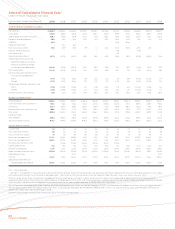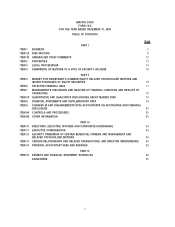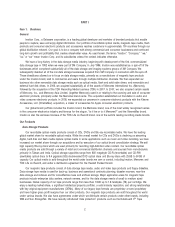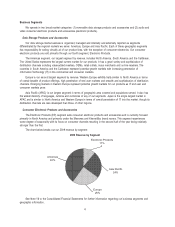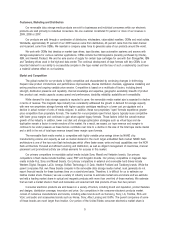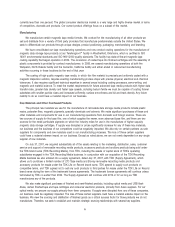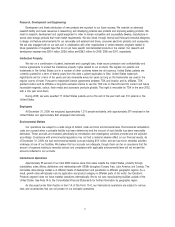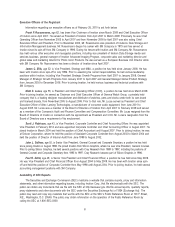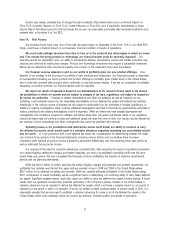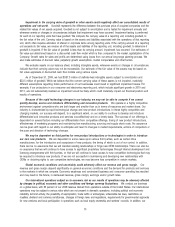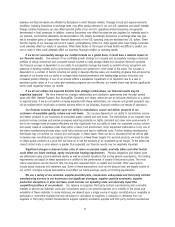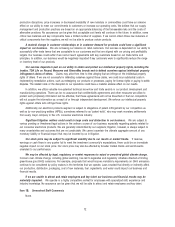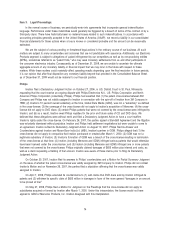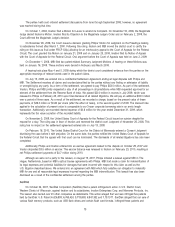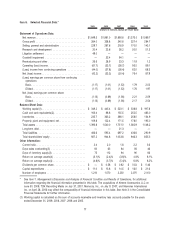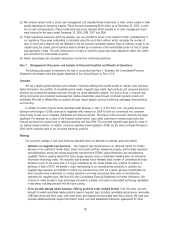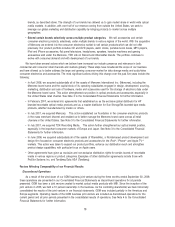Memorex 2009 Annual Report Download - page 16
Download and view the complete annual report
Please find page 16 of the 2009 Memorex annual report below. You can navigate through the pages in the report by either clicking on the pages listed below, or by using the keyword search tool below to find specific information within the annual report.Imation also makes available free of charge through its website (http://www.imation.com) our Annual Report on
Form 10-K, Quarterly Reports on Form 10-Q, Current Reports on Form 8-K, and, if applicable, amendments to those
reports filed or furnished pursuant to the Exchange Act as soon as reasonably practicable after we electronically file such
material with, or furnishes it to, the SEC.
Item 1A. Risk Factors.
Our business faces many risks. Any of the risks discussed below, or elsewhere in this Form 10-K or our other SEC
filings, could have a material impact on our business, financial condition or results of operations.
We must make strategic decisions from time to time as to the products and technologies in which we invest
and if we choose the wrong product or technology, our financial results could be adversely impacted. Our
operating results are dependent upon our ability to successfully develop, manufacture, source and market innovative new
products and services at viable gross margins. Product and technology innovations may require a substantial investment
before we can determine their commercial viability and a return on the investment may never be realized.
Our financial success depends in part on our ability to profitably grow our new product offerings. One
element of our strategy is the sourcing of a portfolio of new products and accessories. Our financial success is dependent
on successfully increasing our brand portfolio and product offerings to profitably grow market share in the United States
and in other key countries with products which contribute to corporate gross margins. If we are not successful in profitably
expanding our product portfolio our financial results could be impacted.
We report our results of operations based on our determinations of the amount of taxes owed in the various
tax jurisdictions in which we operate and are subject to changes in tax laws, regulations, and subject to inspection
by various tax authorities. Changes in related interpretations and other tax guidance as well as inspection by tax
authorities could materially impact our tax receivables and liabilities and our deferred tax assets and deferred tax liabilities.
Additionally, in the ordinary course of business we are subject to examinations by tax authorities in multiple jurisdictions. In
addition to ongoing investigations, there could be additional investigations launched in the future by governmental authorities in
various jurisdictions and existing investigations could be expanded. While we believe we have adopted appropriate risk
management and compliance programs to address and reduce these risks, the global and diverse nature of our operations
means that these risks will continue to exist and additional issues will arise from time to time. Our results may be affected by
the outcome of such proceedings and other contingencies that cannot be predicted with certainty.
Operating losses in tax jurisdictions with deferred tax assets could hinder our ability to continue to carry
the deferred tax assets, which would result in a valuation allowance negatively impacting our consolidated results
and net worth. In a tax jurisdiction with a net deferred tax asset, the considerations for determining whether the asset
can continue to be carried on the financial statements, including various factors such as whether there has been
cumulative profit (defined as pre-tax income adjusted by permanent differences) over the preceding three year period as
well as estimated future pre-tax income.
Our analysis of the need for valuation allowances considered that, after excluding the impact of goodwill impairments
and certain litigation settlement charges and related expenses, we have a consolidated cumulative profit over the most
recent three year period. We also considered the forecasts of future profitability, the duration of statutory carryforward
periods and tax planning alternatives.
While we have a history of profits, excluding the certain litigation charges and expenses and goodwill impairments, our
profitability has declined over the last four years and we recorded a loss in 2008 and 2009 in the United States where
$63.7 million of our deferred tax assets are recorded. While we currently anticipate profitability in the United States during
2010, achievement of overall profitability will be a significant factor in determining our continuing ability to carry these deferred
tax assets. Significant negative events, could also impact our ability to carry the deferred tax assets in future periods. If future
results from our operations are less than projected particularly in the Company’s primary markets in the United States, a
valuation allowance may be required to reduce the deferred tax assets, which could have a material impact on our results of
operations in the period in which it is recorded. If we do not achieve at least moderate levels of pre-tax results in 2010, it is
reasonably possible that we may need to establish a valuation allowance for some or all of the deferred tax assets in the
United States, which could materially impact our income tax provision, financial position and results of operations.
9


